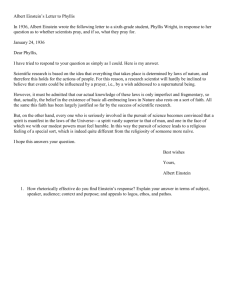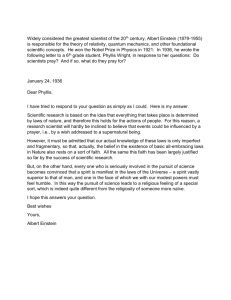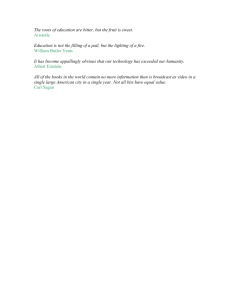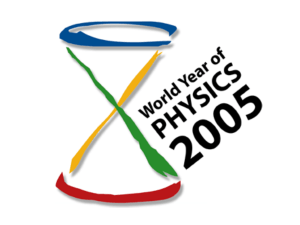Albert Einstein
advertisement
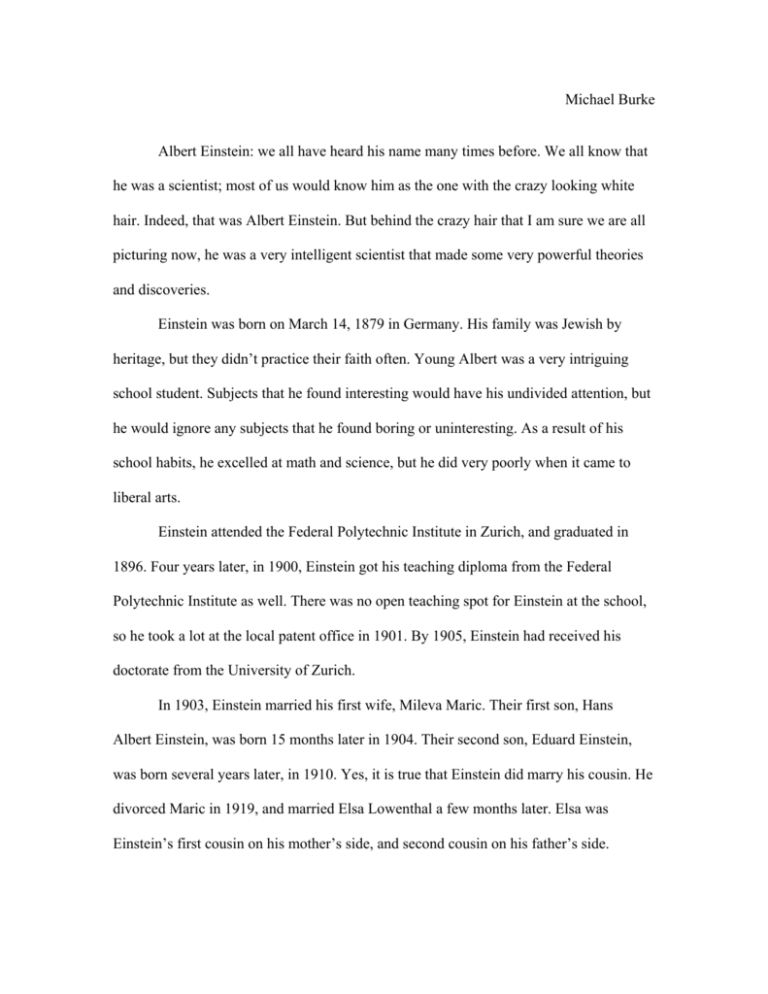
Michael Burke Albert Einstein: we all have heard his name many times before. We all know that he was a scientist; most of us would know him as the one with the crazy looking white hair. Indeed, that was Albert Einstein. But behind the crazy hair that I am sure we are all picturing now, he was a very intelligent scientist that made some very powerful theories and discoveries. Einstein was born on March 14, 1879 in Germany. His family was Jewish by heritage, but they didn’t practice their faith often. Young Albert was a very intriguing school student. Subjects that he found interesting would have his undivided attention, but he would ignore any subjects that he found boring or uninteresting. As a result of his school habits, he excelled at math and science, but he did very poorly when it came to liberal arts. Einstein attended the Federal Polytechnic Institute in Zurich, and graduated in 1896. Four years later, in 1900, Einstein got his teaching diploma from the Federal Polytechnic Institute as well. There was no open teaching spot for Einstein at the school, so he took a lot at the local patent office in 1901. By 1905, Einstein had received his doctorate from the University of Zurich. In 1903, Einstein married his first wife, Mileva Maric. Their first son, Hans Albert Einstein, was born 15 months later in 1904. Their second son, Eduard Einstein, was born several years later, in 1910. Yes, it is true that Einstein did marry his cousin. He divorced Maric in 1919, and married Elsa Lowenthal a few months later. Elsa was Einstein’s first cousin on his mother’s side, and second cousin on his father’s side. Einstein worked in the patent office for about eight years. While there, he wrote some very important papers. The most well known of these papers were his last two; the papers on the Theory of Relativity and the paper with his most well known equation, E=MC2. The second paper he wrote was on the atom; it provided evidence that the atom really existed. Before that paper was published, the existence of the atom was only theoretical. The first paper Einstein wrote in 1905 turned out to be the one that was most accepted in the science world. This paper on the photoelectric effect was the reason that Einstein won the Nobel Prize for Physics in 1921. Simply, the photoelectric effect is a way that energy can be released from a metallic surface. The surface is exposed to electromagnetic radiation, which it then absorbs. This radiation causes electrons to escape from the object; the escaping electrons can create an electrical current. The electromagnetic radiation types that are commonly used are ultraviolet rays or X-rays. It is to an extent the same idea behind a microwave. The main difference is the object that is being exposed to radiation. In a microwave, your food is exposed to less powerful radiation, which causes the electrons in the water to move escape, thus creating heat. Einstein held a few various teaching jobs across Western Europe after his job at the patent office. Einstein never settled down in any of those jobs, he kept moving every year or two. He became the director of the Kaiser Wilhelm Institute for Physics in Berlin in 1914. He stayed at that post for the next 18 years, until Hitler came to power in Germany. When that happened, Einstein resigned his post and came to America; all Jewish professors were forced out of Germany at that time. Starting in 1933, Einstein taught at Princeton; he was assigned to the new Institute for Advanced Study. During his twelve year stay at Princeton, he also worked on another famous theory; his Unified Field Theory. During World War II, Einstein sent a letter to the President Roosevelt. This letter was to urge the president to start research on nuclear fission, since Einstein knew that the scientists in Germany would be doing the same. His letter worked; FDR soon put together a team of researchers that would eventually become the Manhattan Project. Einstein never joined the Manhattan Project, and years later even regretted sending the letter because of the destruction that was caused. Einstein died at the age of 76, on April 18th, 1955. Per his wishes, Einstein was cremated and his ashes scattered. Because he was such a large figure in the science world, Einstein’s brain was preserved. In 1999, a discovery was made; Einstein’s brain wasn’t normal. The part of the brain that deals with speech, reading and writing was missing; to compensate, the part next to it, which deals with mathematical thought, was fifteen percent larger.


